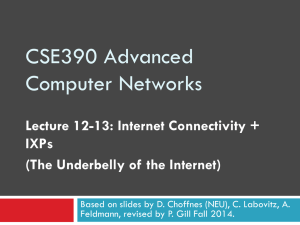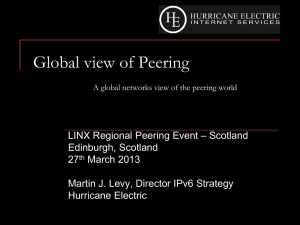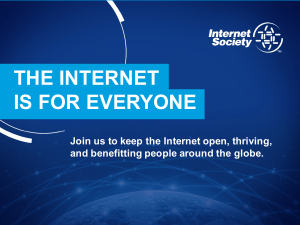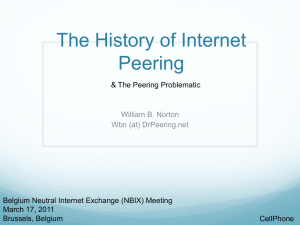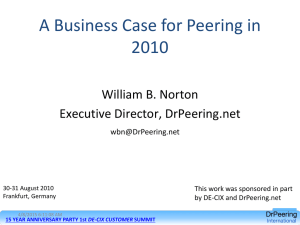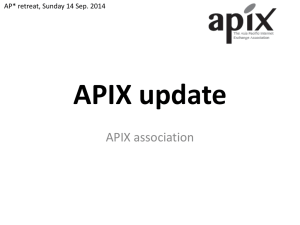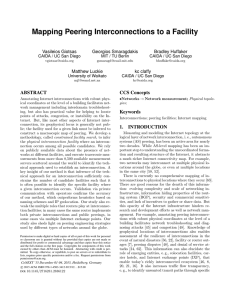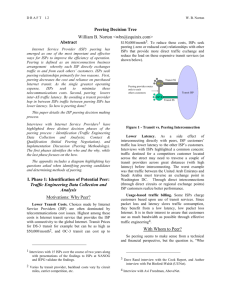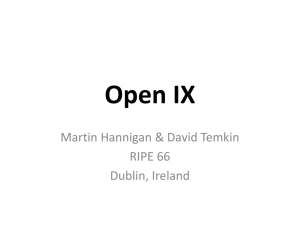The Role IXPs and Peering Play in the Evolution of the
advertisement
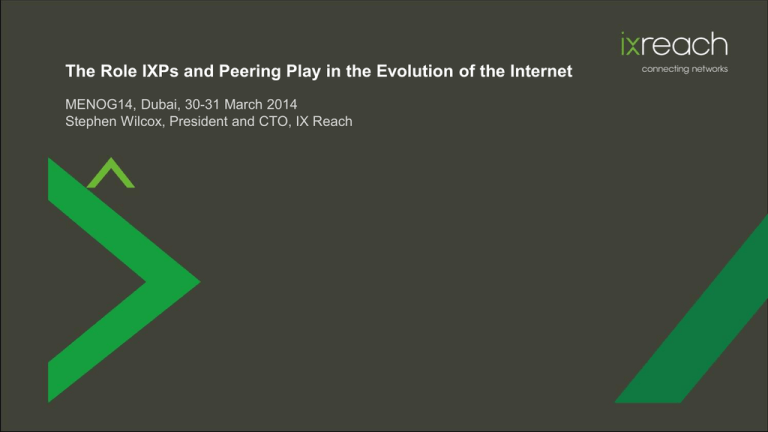
The Role IXPs and Peering Play in the Evolution of the Internet MENOG14, Dubai, 30-31 March 2014 Stephen Wilcox, President and CTO, IX Reach A Quick Introduction ❯ ❯ Stephen Wilcox – founded IX Reach in 2007, President and CTO Global leading provider of wholesale carrier solutions such as: ❯ ❯ ❯ ❯ ❯ ❯ ❯ ❯ ❯ ❯ IX Remote Peering Low Latency Global High-Speed Point-to-Point and Multipoint Capacity Metro and DWDM in Major Cities Enterprise Business IP BGP Transit Cloud Connectivity Solutions (AWS Direct Connect) Colocation 30 major global cities (and growing) 90+ data centres on-net 26 Internet Exchanges partners globally Internet Exchange Points – The Early Days ❯ ❯ ❯ ❯ ❯ ❯ ❯ Early Internet evolved in the US In the early to mid 90s everyone bought Transit from Tier 1 ISPs Most content originated within the US, long international circuits This led to high costs for local operators They ultimately gathered together to create local points of interconnections to reduce costs and improve user experience This resulted in more traffic remaining within national borders The resulting IXPs were set up by academic and research networks or by telecom operators Internet Exchange Points – The Situation Today ❯ ❯ ❯ ❯ ❯ ❯ ❯ ❯ ❯ 400+ Internet Exchanges around the world The majority, and largest, are concentrated in Europe (over 50) Only a few are classed as international hubs But all play a part in ASN topology and evolving the Internet Daily traffic volumes are comparable to those seen by largest global Tier 1 ISPs The largest are increasing their services and expanding to become multi-site IXPs (or bigger brands) IXPs are widely considered to help develop markets IXPs are critical for understanding how content is distributed in today’s Internet and how the different networks are adapting to the changing nature of content distribution Lower costs of peering eg resellers drive viable peering long distances Example Major IXP Infrastructure Source: DE-CIX Source: LINX 10.00$ Gbit/s$ Average$and$Peak$traffic$ 10000.00$ Average'traffic'rate'Gbit/s' 4&Dec&13$ 4&Dec&12$ 5&Dec&11$ 5&Dec&10$ 5&Dec&09$ 5&Dec&08$ 6&Dec&07$ 6&Dec&06$ 6&Dec&05$ 6&Dec&04$ 7&Dec&03$ 7&Dec&02$ 7&Dec&01$ 7&Dec&00$ 8&Dec&99$ 8&Dec&98$ 8&Dec&97$ Source: AMS-IX 8&Dec&96$ 0.01$ Max'traffic'rate'Gbit/s' 1000.00$ 100.00$ 1.00$ 0.10$ Benefits and Key Observations of IXP Activity ❯ Tier-1s are members at IXPs and do public peering ❯ Typically ‘restrictive’ peering policy ❯ Most IXP members use an ‘open’ peering policy ❯ Many IXPs make it very easy for its members to establish public peerings with other members ❯ ‘Handshake agreements’ ❯ Use of IXP’s route server is offered as free value-added service ❯ Use of multi-lateral peering agreements ❯ Most peering links at an IXP see traffic, they’re not just for backup ❯ Most of the public peering links see traffic ❯ Does not include traffic on the private peering links at IXP Benefits and Key Observations of IXP Activity ❯ Large IXPs are starting to look more and more like networks ❯ Offering SLAs (DE-CIX in 2008, AMS-IX in 2011) ❯ Support for IXP resellers (e.g. IX Reach) ❯ Expanding geographically (both domestically and internationally) - becoming multi-site IXPs and using their ‘brand’ (e.g. France-IX Marseille, UAE-IX powered by DE-CIX, the US market and Open-IX community) ❯ Extensive monitoring capabilities ❯ Small IXPs are expanding regionally and offering remote peering to bigger IXPs (e.g. LUCIX’s Central European Peering Hub ❯ Some have their own partial networks and offer connectivity - anything to help connect new members ❯ It is becoming increasingly difficult to differentiate between international and local peering, and Networks and Internet Exchanges Peering Patterns Geographically ❯ ❯ ❯ ❯ Lack of local peering infrastructure normally means higher bandwidth pricing in many emerging markets (history repeating itself) Traffic is sent internationally that would be more economical to keep local, e.g. as seen in the Middle East and parts of AsiaPac The US, historically, didn’t have the same commercial drivers being dominated by national Tier1s. IXPs were often commercially operated by these operators e.g. Worldcom and later as a secondary value add service e.g. Equinix and Telehouse Expanding IXPs helps keep local traffic local, unburdens expensive interregional links and stimulates investment in local networks European IXP Model Vs the US IXP Model ❯ ❯ ❯ Managed non-profit IXPs are now moving to the USA with the support of the Association Open-IX North American IXP marketplace is dominated by for-profit IXPs IXPs in North America have less peerings historically Source: Euro-ix Source: PCH Peering vs Transit – A Reminder Peering: ❯ Settlement-free interconnection between two networks ❯ Cost efficient ❯ Traffic optimisation and low latency ❯ Scalability and redundancy ❯ Improved end-user experience – closer to the eyeballs ❯ Community and marketing Transit: ❯ Connecting smaller ISPs, for a fee, to the larger Internet ❯ Historically more expensive ❯ No control over routes Influence from Remote Peering ❯ AMS-IX, “75% of new members come from reseller partners” ❯ ❯ ❯ ❯ ❯ No local infrastructure at the IXs Typically bundled pricing and deployment model – One Stop Solution Lower operational and capex costs Fast turn up compared to traditional physical deployment (hours vs weeks) Peering is more accessible to smaller/medium sized networks and developing markets Provider Typical Peering Relationships ❯ Open peering ❯ Selective peering ❯ Restrictive/Closed peering ❯ Similar sized ISPs peer together ❯ Upstream providers sell Transit to lower Tiers when traffic is not balanced ❯ Forming network of interconnections that creates the Internet Which looks a bit like this… Internet Map 2000s Internet Map Today Peering on a Handshake ❯ Peering model isn’t perfect ❯ 99.5% of peering is on a handshake ❯ Tiers 2 and 3 free peer with Tier 1s (when profitable) ❯ Peering ratios and bandwidth share are scrutinised ❯ De-peering can occur when unbalanced ❯ Tier 1s have more power and can apply pressure ❯ Smaller Tiers are forced to pay or they’re de-peered ❯ Potential disruption to end-users ❯ Potentially huge financial losses to smaller Tiers Cases of De-Peering ❯ 2005, Level 3 Communications de-peered Cogent ❯ Isolation of millions of IP addresses ❯ December 2002, Cogent and AOL during a ‘test’ peering ❯ 2005, Level 3 Communications and XO Communications ❯ October 2008, Cogent and Sprint. ❯ 289 single homed autonomous systems behind Cogent and 214 autonomous systems behind Sprint were unable to connect to each other Non-US Cases of De-Peering ❯ March 2008, Cogent USA and Telia in Sweden ❯ Outage that lasted from 13th March, 2008 to 28th March, 2008. ❯ Mostly impacted US customers of Cogent and North-Central Europe customers served by Telia. ❯ 1.6% of the routes in the global routing table were partitioned ❯ January 2011, Egypt de-peered themselves ❯ First de-peering of its kind in Internet history ❯ Attempt to block routing information between international ISPs during the revolution ❯ April 2005, France Telecom and Cogent ❯ France Telecom tried to get Cogent to pay to reach their customers in their territory ❯ March 2012, Cogent and China Telecom Avoiding Non-Technical Network Issues ❯ Don’t rely too heavily on one transit provider, capacity plan carefully ❯ Peer directly with your important ASNs: ❯ Overbuild peering to allow failover and improve connection quality ❯ Peer publicly and privately ❯ Prepare to pay for peering for important traffic ❯ Have a backup solution for both technical and non-technical issues of de-peering ❯ Multi-home – a single incident is less likely to affect you ❯ Use agreements with monopoly providers, build in flexibility IXPs’ Impact in the Future ❯ ❯ ❯ ❯ ❯ ❯ Richness in peering and opportunities for flexible and sophisticated routing policies Makes strategic alliances between ISPs and CDNs more attractive for end user content delivery that’s faster and more efficient Internet traffic flow analysis becomes increasingly more difficult as peerings increase and diversify Rise in Cloud providers adds an additional layer of complexity IXPs provide a valuable ‘vantage point’ for traffic analysis on both a local and international level Increased number of multi-site IXPs may decrease the level of international peering at major IXPs Trends and Evolution ❯ Smaller networks become more global as transport costs fall and ❯ ❯ ❯ ❯ remote peering becomes more common Move of content from being seen as a customer to being a main player in the Internet core Increased interconnection between regional networks and major content providers (“donut peering”) Shift of traffic away from historical Tier1s towards direct peering between networks and content Increasingly content delivered directly into a network operators network More information ❯ Any questions? ❯ Contact: ❯ Email: steve.wilcox@ixreach.com ❯ Web: www.ixreach.com ❯ Services: enquiries@ixreach.com

